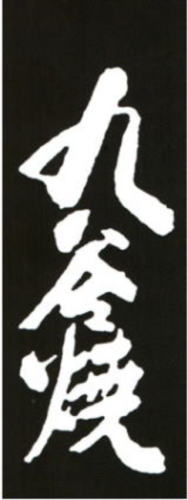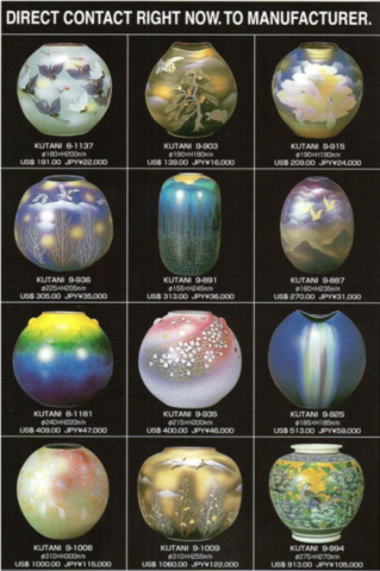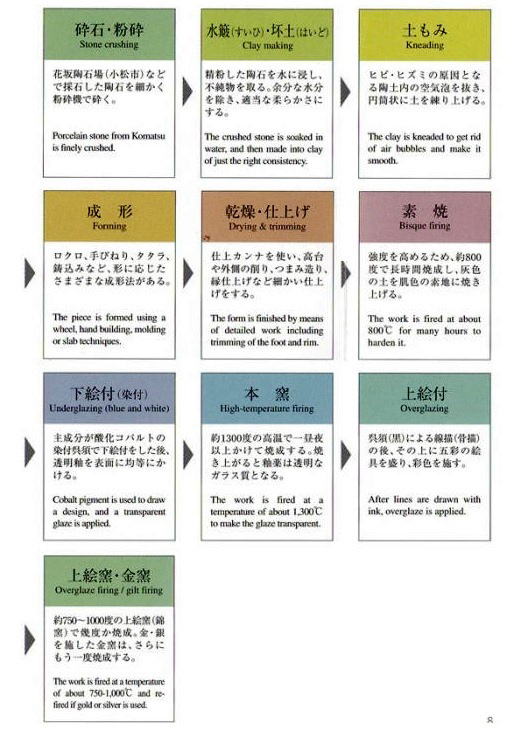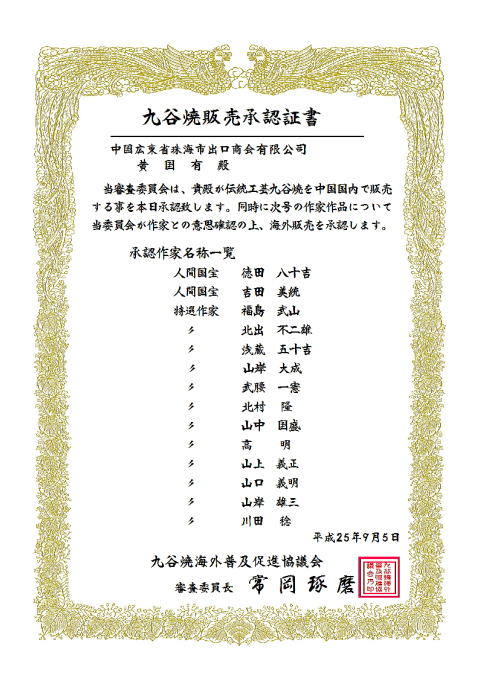九谷焼-ガイドブックKUTANI-GUIDE BOOK
 |
KUTANI JAPAN 350 years have passed since Saijiro Goto first fired Kutani-yaki pottery in the Kutani village of Kaga (current Ishikawa prefecture)in the early Edo period(17th century) Kutani-yaki is a traditional craft characterizzed by vivid designs and the use of five distinctive colors,and has been enjoyed by people throughont the world. We hope you will tresure your purchase. KUTANI EXPORT COMMITTEE KUTANI OVERSEAS EXPORT NOW |
 |
歴史と伝統に培われた九谷焼
日本を代表する名窯は、江戸初期に加賀国江沼郡九谷村で焼かれたことから、その地名にちなみ九谷焼と称されています。
お客様のおもてなし、豊かなこころの安らぎに、さらに人生の節目の贈り物として、九谷焼は本物が醸し出す魅力に溢れています。
ROMANTIC HISTORY OF 350 YEARS SUPPORTED BY “GOSAI” (FIVE COLORS)
Ko-Kutani of early stage Progressed under the support of the Daishoji clan in 1655. After the discovery of potter’s clay at a mine near Kutani village, Saijiro Goto was sent to Arita in
A lot of kilns were built such as Mokubei kiln the Yoshida-ya kiln, the Miyamoto kiln, and Eiraku kiln, developing each special style.
In the Meiji period, Shoza Kutani developed his own style. Which became popular for it’s painting of “Saishiki-kinrande” with all styles putting together and the works of his apprentices were exported to get a high position as Industrial Arts of Kutani.
1655年(明暦元年)頃、大聖寺藩(加賀藩の分家)はこの地の陶石をもとに開窯。
創出された磁器は、後に「古九谷」と呼ばれ、日本色絵磁器の礎となりました。
青(緑)、黄、赤、紫、紺青―。濃厚な色彩が自由闊達に躍る上絵は、九谷焼の“美の源流”です。
しかし、わずか半世紀で謎に包まれた廃窯。
その約100年後、加賀藩の奨励により九谷焼はふたたび覚醒します。春日山窯、若杉窯が開窯、「再興九谷」の気運に乗じた吉田屋窯らが次々に色絵磁器を生産するなど、さまざまな感性が競い合い融合し、今日に受け継がれる百花繚乱の上絵技術が誕生しました。
近代においては、華やかな彩色金襴手の作風が「ジャパンクタニ」の名で欧米に深く浸透しています。
「古九谷」に端を成す芸術性と「再興九谷」で備わった用の美を具有する九谷焼は、時空を超えて、今もさらなる飛翔を続けます。
The origin of the five spectacular Kutani colors
At the upper reaches of the
A stone monument bearing the inscription “Ko-Kutani kiln ruins” stands quietly in a clearing.
It marks the spot where the Daishoji Clan (a branch of the Kaga Clan) established a kiln in about 1655, to make use of the local porcelain stone.
The porcelain ware that was created there was later called “Ko-Kutani,”and became the foundation for Japanese colored porcelain ware.
Rich overglaze colors applied with fluid brushwork - green, yellow, red, purple and blue – give Kutani porcelain its characteristic beauty.
However, only half a century later the kiln was abandoned for reasons that nobody knows.
About 100 years later, Kutani porcelain was revived under the patronage of the Kaga clan.
The Kasugayama and Wakasugi kilns were established, and kilns such as the Yoshidaya kiln rode on the momentum of “revived Kutani”, all producing overglaze porcelain ware. Various styles competed and combined to develop into the overglaze techniques that have been handed down to this day.
In modern times, the gorgeous Kinrande style has become well known in the West as “Japan Kutani.”
Kutani porcelain, which combines the artistry of Ko-Kutani ware and the utilitarian beauty that developed from “revived Kutani”, continues to evolve.
凛として花開く・・・加賀百万石の伝統工芸「九谷焼」
江戸時代、前田家が統治した百万石の大藩、加賀藩。文化芸能に精通した歴代藩主らは文治政策を奨励し、「九谷焼」をはじめとする工芸王国を作り上げました。
その土壌を育んだのは、霊峰白山、加賀平野、日本海が織り成す景観と食の豊穣。
伝統工芸のふるさと石川県には、受け継がれる日本の美が息づいています。
A traditional craft promoted by the wealthy Kaga clan
In the
What made that luxury possible were the local geographical features-Mt.Hakusan, the Kaga Plain and the
In Ishikawa, a prefecture with a tradition of outstanding craftsmanship, Japanese-style beauty is still alive and well.
豪胆に緻密に・・・多彩に魅せる色絵の伝統
加賀藩の歴史とともに、鮮やかに花開いた数々の色絵窯。安土桃山時代の豪放磊落な武家文化、雅で華麗な京文化を自在に取り入れながら、独自の表現が生み出されました。
長い年月の間にも決して風化することのない様式。九谷焼の誇りでもある伝統の“六様式”です。
Boldness and precision: the charm of traditional overglaze decoration
As the Kaga rule progressed, mode and more porcelain producers prospered. Incorporation of the bold samurai culture of the Azuchi Momoyama period and the sophisticated culture of
The traditional six styles, which have remained distinct over all these years, are the pride of the Kutani porcelain industry.
古九谷風 こくたに 明暦元年(1655)~
大聖寺藩初代藩主前田利治が命じ、九谷村で焼かれたもので、青(緑)、黄、赤、紫、紺青の五彩を用い、絵画的に豊かに表現された様式。狩野派の影響を受け、のびやかで自由な線で描かれ、大胆な意匠と絢爛たる色遣いが特徴。
Ko-Kutani style 1655~
Works of this style were fired in
木米風 もくべい 文化4年(1807)~
古九谷廃窯約100年後に、加賀藩営で金沢に春日山窯が開窯。京都より招かれた文人画家青木木米の指導で、全面に赤を施し、五彩で中国風の人物などを描写した様式。
Mokubei style 1807~
This style established under the leadership of Aoki Mokubei, who was summoned from
吉田屋風 よしだや 文政7年(1824)~
豪商吉田屋伝右衛門が再興九谷を目的とした窯で、青手古九谷の塗埋様式を踏襲した様式。青(緑)、黄、紫、紺青の四彩を用いて、様々な文様や小紋を駆使し、全面を塗り埋めた重厚感のある作風が特徴。
Yoshidaya style 1824~
Yoshidaya Denemon wanted to revive Ko-Kutani, and copied the Aode Ko-Kutani style. Various patterns and designs in green, yellow, purple and blue are used to cover the entire surface.
飯田屋風 いいだや 天保2年(1831)~
吉田屋窯を引き継いだ宮本屋窯で焼かれた様式。赤で綿密に人物を描き、まわりを小紋等で埋め尽くし、金彩を加えた赤絵細密画で、主工飯田屋八郎右衛門から八郎手とも呼ばれている。
Iidaya style 1831~
This style was used at the Miyamotoya kiln. It features detailed figures in red on a background filled in with patterns, with added gold.
庄三風 天保12年(1841)~
古九谷、吉田屋、飯田屋、金襴手のすべての手法を融合し、名工九谷庄三が確立した彩色金襴手の様式。明治以降は「ジャパンクタニ」として産業九谷の主流となった作風。
Shoza style 1841~
This style, established by Kutani Shoza, is a combination of Ko-Kutani, Yoshidaya, Iidaya and Kinrande. Starting in the Meiji period, it became known as “Japan Kutani.”
加賀藩分家の大聖寺藩が開いた九谷本釜で焼かれた様式。京都の名工永楽和全による金襴手手法で、全面を赤で下塗りし、その上に金のみで彩色した豪華で洗練された作風。
Eiraku style 1865~
Works of this style, introduced by Eiraku Wazen, were made at a kiln established by the Daishoji clan. The whole surface is covered with red, and the design is in gold.
日々土と語らい・・・魂を込める
丹精こめて土を練り上げ、成形し、絵を描く。九谷焼の行程は、無垢なる自然に、人の魂を注ぎ込む作業です。その流れをつなぐのは熟達した技と美意識。作り手たちによってあくことなく繰り返される修練と模索が、九谷焼の今日を支えています。
Kutani clay is kneaded, formed, and decorated with a lot of feeling. The production prosesses naturally incorporate the spirit of the craftsmen, whose skill and sense of beauty still support the Kutani industry of today.
九谷焼の完成まで Production stages
 |
近代から未来へ・・・九谷焼の現代画法
明治期以降、創作意欲盛んな名工たちは、さらなる到達点を目指し、独自の画法を模索。圧倒的な描写力、秘法ともいわれる釉薬技術、立体的な表現方法を用いた現代の画法は、九谷焼の新たな可能性を拓きました。
Ever since the Meiji period, creative master craftsmen have sought to develop new, unique style of brushwork. Modern brushwork, which includes skillful graphic depiction, sophisticated glazing techniques, and three-dimensional expression, has paved the way for new possibilities in the world of Kutani porcelain.
和歌や漢詩などを非常に微細な字で緻密に描き込む手法。盃や湯呑の内側に描く場合には、さらに高度な技術が求められる。
Saiji
This is the technique of writing classical poetry on ceramic ware with tiny, delicate brushstrokes.
地色の上に青く盛り上がった細点を均一に並べる手法で、丹精で上品な趣きが薫る。ほかに白粒、金粒がある。
Aochibu
A pattern of tiny blue dots is created on the clay surface to create an elegant look.
五彩の上絵具を塗り分け、塗り重ねながら器全体を覆っていく。優美な色彩と濃淡の変化に特徴があり、幻想的な雰囲気を醸し出す。
Saiyu
The whole surface is covered with overglaze decoration that features exquisite colors and nuances of shading.
花詰 はなづめ
牡丹や菊など四季折々の花々を、金彩・銀彩・五彩の上絵付で器を埋め尽くすように描き、絢爛豪華な魅力にあふれる。
Hanazume
The whole surface is covered with gorgeous overglaze flowers in gold, silver and the five Kutani colors.
釉裏金彩 ゆうりきんさい
金粉や金箔の上に、透明な釉薬をかけて焼き上げる手法。深みのある金色の輝きが美しい。銀を用いた釉裏銀彩もある。
Yuri Kinsai
Clear glaze is applied over gold powder or gold leaf to create a gorgeous finish.
盛 もり
獅子や招き猫などの置物によく見られる手法。専用の絵具を使って盛り上げた立体的な模様が特徴で、大胆さ豪快さを感じさせる。
Mori
Special glazes are used to create bold raised patterns on traditional ornaments such as lions and beckoning cats.
ほんとうの贅沢は・・・毎日の暮らしの中に
感性に合う器で楽しむ料理。
手肌にしっくりとなじむ器と一服のお茶。
使い込むほど味わい深まる酒器・・・
いい器との出合いは、心を豊かにしてくれます。
昔も今も「九谷焼」が提供し続けるのは、そんな暮らしの中の贅沢さです。
Aesthetically pleasing dishes to eat from
A leisurely cup of tea out of a cup that feels just right in your hand...
A sake cup that takes on a warmer feel the more you use it...
Good ceramic ware lifts the spirit.
That’s the kind of luxury that Kutani porcelain gives you.
九谷焼年表 Kutani porcelain chronology
| 1655年明暦元年 | 大聖寺藩初代藩主前田利治公の命により九谷村で開窯(古九谷窯跡より「明暦元年六月廿六日田村権左右衛門」と書かれた花瓶の一部が旧九谷村の神社より発見)A kiln was built Kutani Village on the order of the first lord of the Daishoji clan, Maeda Toshiharu. (Part of a vase bearing the inscription “June 26, 1655 Tamura Gonzaemon,” indicating that it was fired in the Ko-Kutani kiln, was discovered in the shrine of the former |
| 1656年明暦2年 | 古九谷窯で色絵磁器が焼かれる(「明暦弐歳九谷八月」と書かれた色見陶片が出土) Overglaze porcelain ware fired in the Ko-Kutani kiln.(A shard bearing the inscription “August 1656, Kutani” was excavated at the site.) |
| 1807年文化4年 | 青木木米の指導のもと、金沢卯辰山に「春日山窯」を開窯。Kasugayama kiln established in Utatsuyama, |
| 1811年文化8年 | 本多貞吉、花坂村(現小松市)に陶石を発見し「若杉窯」を始める。 Honda Sadakichi discovered porcelain stone in |
| 1819年文政2年 | 藪六右衛門、「小野窯」を始める Yabu Rokuemon established Ono kiln. |
| 1824年文政7年 | 吉田屋伝右衛門、旧九谷村に「吉田屋窯」を築窯し、1年余りで窯を山中の越中谷に移す。Yoshidaya Denemon built the Yoshidaya kiln in the former |
| 1831年天保2年 | 吉田屋窯支配人宮本宇右衛門が吉田屋窯を引継ぎ、飯田屋八郎右衛門を招き「宮本窯」を開く。Miyamotoya Uemon took over the Yoshidaya kiln, invited Iidaya Hachiroemon and established the Miyamoto kiln. |
| 1841年天保12年 | 九谷庄三、旧寺井村(現能美市)に「寺井窯」を開窯。Kutani Shoza established Terai kiln in former |
| 1848年嘉永元年 | 大聖寺藩、藩営で「松山窯」を開く。Daishoji clan established Matuyama kiln. |
| 1860年万延元年 | 大聖寺藩、宮本窯を買い入れ「九谷本窯」とする。Miyamoto kiln purchased by Daishoji clan and turned into main Kutani kiln. |
| 1865年慶應元年 | 大聖寺藩、九谷本窯に京都より永楽和全を招く(「永楽窯」)Eiraku Wazen invited from |
| 1873年明治6年 | ウィーン万博に出品。Works exhibited at Vienna Expo. |
| 1876年明治9年 | フィラデルフィア万博に出品。Works exhibited at Philadelphia Expo. |
| 1878年明治11年 | パリ万博に出品。Works exhibited at Paris Expo. |
| 1908年明治41年 | 九谷茶碗まつり始まる。First Kutani Chawan Festival |
| 1975年昭和50年 | 九谷焼が通商産業省(現経済産業省)より伝統的工芸品に認定される。 Kutani porcelain recognized as a traditional craft by Ministry of International Trade and Industry(Present-day Ministry of Economy, Trade and Industry ). |
| 1997年平成9年 | 「国際色絵陶磁器フェア‘97九谷」を開催。 Held “International Overglaze Ceramics Fair ’97 Kutani" |
| 2004年平成16年 | 九谷焼無鉛上絵具の完成。Development of lead-free overglaze for Kutani porcelain |
| 2004年平成16年 | 第1回景徳鎮国際陶磁博覧会に出品。Works shown at 1st Jingdezhen International Ceramics Exhibition. |
| 2005年平成17年 | パリメゾン&オブジェに出品。Works shown at Maison & Objet exhibition in |
●九谷焼海外輸出販売事例
●輸入業者名 : 日鉄インターナショナルINC
●代表者 : 常岡 琢磨
●※近時過去7年輸出件数
2006年 15件
2007年 14件
2008年 13件
2009年 9件
2010年 7件
2011年 9件
2012年 14件
※大口受注処理件数
| 海外発送国別 | カスタマー | 発送個数 |
| スエーデン | バイエルンINC | 42 |
| デンマーク | ロイヤルコペンハーゲンAS | 68 |
| デンマーク | GHフォームAS | 36 |
| オランダ | HIBIYA | 30 |
| オーストラリア | コロニアルキャスティングPTY | 30 |
| ニュージーランド | ハッチウィルコPTY | 36 |
| 中国 | 珠海市公司 | 52 |
| 中国 | マカオ市ベネチアンH | 64 |
| 中国 | マカオ市ベネチアンリゾート | 40 |
| デンマーク | オーフスアンランバー | 42 |

バナースペース
常岡.篠田北欧美術館
 〒731-5128
〒731-5128
広島市佐伯区五日市中央1-10-12
TEL 082-942-5539
FAX 082-942-5540
携帯 090-6413-6161
